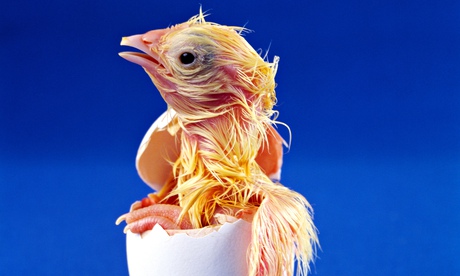
Easter is fast approaching, which probably hasn’t escaped your notice. It certainly hasn’t escaped mine. Having a five-year-old who asks you every day how many more sleeps it will be until the Easter bunny comes round tends to sharpen your calendrical awareness.
Easter is an ancient festival of rebirth, but it’s also an excellent excuse for eating eggs. I really like eggs, of both the chocolate and chicken variety. But the chocolate ones, you must admit, can sustain only a fleeting interest. A sweet, sugary hit – and then it’s gone. The chicken ones, on the other hand, are really quite fascinating, once you scratch beneath the shell. I’ve written a little about chicken eggs before, but I think they deserve revisiting, because those delicious little packages of food, which are good in so many ways – boiled, poached, fried, scrambled, omeletted – really are biological wonders.
The shell plays an obvious role in protecting the delicate, wet contents. The egg white also plays a protective role, as well as forming a source of protein. The yolk – in a fertilised egg, kept warm and allowed to develop – provides important nutrients to the chicken embryo. But what about oxygen? Have you ever wondered how a chick, or indeed an embryonic lizard, or a crocodile, breathes while inside its egg? Certainly, if you were to place a fertilised chicken egg under water, the chick inside would be starved of oxygen and would suffocate. So, somehow, the embryonic chick is normally able to absorb oxygen from the air outside the egg. It achieves this with the aid of a membranous bag, called the allantois, which is attached at one end to the chick’s gut, while the other end lies close to the inner surface of the egg shell.
The allantois develops early on in chick embryonic development, as an elongated, sausage-shaped (this is what “allantois” means) pouch which grows out of the bottom part of the chick’s developing gut. But instead of being contained inside the body of the embryo, the allantois protrudes out, and fuses with another membrane which envelopes the chick and its yolk, called the chorion. This fused “chorioallantoic” membrane has a network of blood vessels within it. Lying up against the inner surface of the porous eggshell, this is where gas exchange takes place. Oxygen diffuses through the egg shell, then through the walls of capillaries in the chorioallantoic membrane into the blood, while carbon dioxide passes out in the other direction. The blood in the membrane is on the move – the pumping of the chick’s heart pushes blood around its body – but also out to through the allantois, to the chorioallantoic membrane, and back.
Carbon dioxide isn’t the only waste product that the chick needs to get rid of – and this is where the inside of the hollow allantois comes in: it’s used as a bag to store nitrogen-containing waste. When the chick hatches, it leaves its chorioallantoic membrane behind, still attached to the inside of its eggshell. Don’t bother looking for traces of the allantois in your unfertilised breakfast egg though – it only forms as part of a developing embryo. If there’s no chick inside the egg, there’s no allantois.
But you had an allantois. Yes – you. You may be a fully grown adult now, perhaps even with a few joint pains that seem to have crept up on you in recent years, and maybe even a few grey hairs… but you were an embryo once. Hang on a minute, I hear you cry. I may have been an embryo, an impossibly long time ago – but I wasn’t laid in an egg! I’m not a chicken. What business would I have with an allantois?
This is one of the fantastic things about embryology – you discover that you have more in common with other animals than you might have suspected. Look at the developing embryo of any reptile, bird or mammal, and you’ll find a yolk sac and an allantois. Both make perfect sense in the egg-laying reptiles and birds – and in those few strange mammals that also lay eggs, like the duck-billed platypus. But in a mammal like us, which doesn’t lay eggs, and which instead “lays” live babies, what’s the use of a yolk sac or an allantois? We’re placental mammals after all; in the womb, the placenta allows us to grab the nutrients and oxygen we need from our mother’s blood, and to get rid of our waste in the same way. The yolk sac forms, but is later completely obliterated. The main reason we develop one at all seems to be a historical one: our (egg-laying) ancestors did, and so we do too. On the face of it, the allantois also seems to be vestigial and redundant, but we need to watch that developing embryo carefully, to see what it turns into.
Embryology reveals surprising similarities between early embryos of seemingly quite different animals. And it also shows that some structures that may look very different later on have fundamental similarities in the way they form. Just like a chick then, as an early embryo, you had an allantois, and a chorioallantoic membrane. And these didn’t just disappear as you grew larger in your mother’s womb, as the yolk sac does. They grew with you, and vessels developed in them, just as they do in the chick. Your chorioallantoic membrane merged with your mother’s womb to become the placenta itself. Your allantois became your umbilical cord – containing vessels that conveyed blood out to the placenta and back into your tiny body – creating a life support system that would connect you to your mother and sustain you until the day you were born. Until the day you hatched out into the world.







